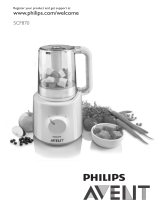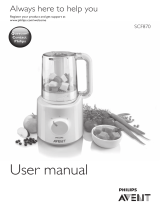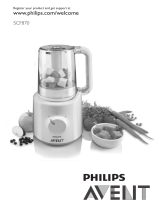
- Do not disassemble the motor unit for maintenance or cleaning purposes. Take it to an
authorised Philips service centre for repair.
Caution
- Never use any accessories or parts from other manufacturers or that Philips does not specically
recommend. If you use such accessories or parts, your guarantee becomes invalid.
- Do not place the appliance on or near an operating or still hot stove or cooker.
- Always unplug the appliance and let it cool down before you clean it.
- Never use the jar or any other part of the appliance in a microwave, as the metal parts of the
jar handle and blade unit are not suitable for this use.
- Never sterilise the jar or any other part of the appliance in a steriliser or in a microwave, as the
metal parts of the jar handle and blade unit are not suitable for this use.
- This appliance is intended for household use only. If the appliance is used improperly or for
professional or semi-professional purposes or if it is not used according to the instructions in the
user manual, the guarantee becomes invalid and Philips refuses any liability for damage caused.
- Be careful when you pour hot liquid into the beaker, as hot liquid and steam may be ejected and
cause scalding.
- Let the appliance cool down for 10 minutes before you steam another batch of ingredients.
- The appliance is not intended for chopping hard ingredients such as ice cubes and sugar cubes.
- Do not let the appliance blend for more than 30 seconds at a time. If you have not nished
blending after 30 seconds, switch off the appliance and wait a few seconds before you continue.
If the appliance becomes hot, let it cool down for a few minutes before you continue.
- Place the appliance on a stable, horizontal and level surface. Make sure there is enough free
space around it to prevent damage to e.g. cabinets or other objects, as the appliance emits hot
steam during use.
- Do not use the appliance if it has fallen or is damaged in any way. Take it to an authorised Philips
service centre for repair.
- Never put water, other liquids or blended food in the jar for steaming to avoid damage to the appliance.
- Never use the steaming function without water.
- Make sure that you do not overll the water tank (max. 200ml). Do not exceed the maximum
level indicated on the measuring cup.
- When you steam ingredients, make sure that you do not overll the jar. Make sure that the top
edge of the green blade unit is not covered with food (Fig. 2).
- When you blend liquids, do not exceed the maximum level indicated on the jar (450ml).
- Do not insert any object into the lling opening or the steam outlet.
- Never rell the water tank during the steaming process, as hot water and steam may come out
of the appliance as a result.
- Always make sure that the lid has cooled down after steaming before you open it to add more
ingredients for blending, if necessary.
- Do not connect the appliance to an external switching device such as a timer and do not
connect it to a circuit that is regularly switched on and off by the utility. This prevents a hazard
that could be caused by inadvertent resetting of the thermal cut-out.
-
Always check the temperature of the baby food on the back of your hand before you feed your baby.
- Always check the consistency of the baby food. Make sure there are no chunks in the food.
- When the steaming process (max. 20 minutes) is nished, do not steam or reheat the baby food again.
- Only use the spatula supplied remove the food from the jar.
- Regular descaling prevents damage to the appliance.
- Children shall not play with the appliance.
- Switch off the appliance and disconnect from supply before changing accessories or approaching
parts that move in use.
- Take care in handling the sharp blades when emptying the jar and during cleaning.
- Always disconnect the device from supply if it’s left unattended.
- Cleaning and user maintenance shall not be made by children.
ENGLISH 7


























